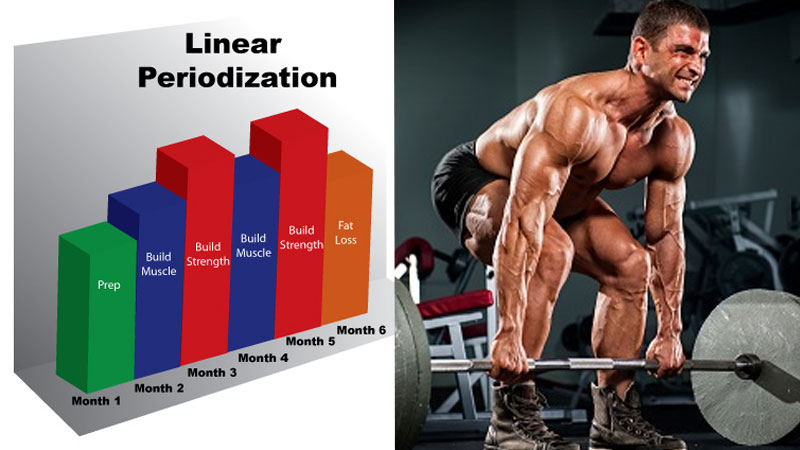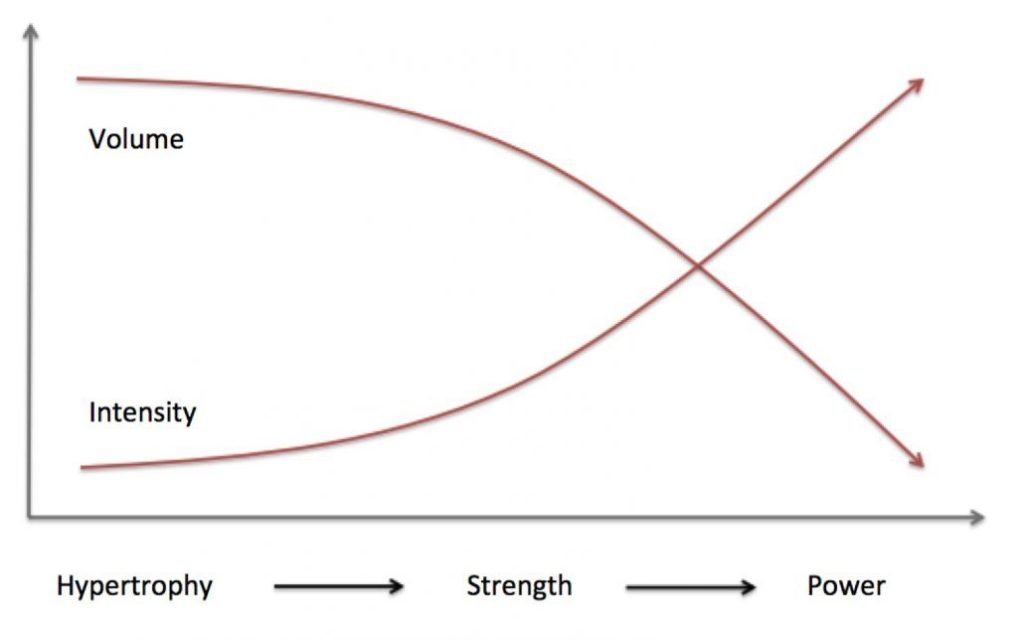
Planning your training in advance with linear periodization will take you one step closer to a more muscular, jacked and downright intimidating physique.
There’s more to great exercise planning than just rocking up, jumping on whatever equipment is free and hoping for the best.
Yeah, it’ll get you a bit of muscle and you’ll most definitely improve your strength. But for optimal progress that’ll help you smash the ceiling on your genetic potential you’ve got to get planning brah.
Serious lifters take the time to plan their workouts in advance, taking into account volume, load and recovery. The pros don’t wing it… and neither should you.
That’s where linear periodization comes in. For both performance and linking periodization, bodybuilding and strength training too.
You might need to take out your pen and paper for this one (quill and ink if you’re a hipster) and spend an evening or two detailing the program.
But linear periodization is a sure fire way of making your training more efficient, streamlined and effective.
This is our idiot’s guide to linear periodization…
What Is Periodization?
The most successful lifters and athletes are the ones that go balls deep in the science of training to apply it to their own training and improve the way they lift.
‘Evidence-based practice’ is a big part of the moderns bros arsenal.
And that means learning about the nuances and intricacies of training variables and planning.
Periodization originated in Russia in the 1950’s and was based on typical Soviet mentality at the time – cold, objective and based around long-term progression.
In a nutshell, periodization is a training method consisting of different phases of training based around muscle growth, strength and power.
It’s the headmistress of training approaches. A bit of a bitch, but it does have your best interests at heart.
Although zero research at the time, Russia (and other eastern bloc countries too) used periodization as a way of getting their athletes in the best shape possible.
Stress, periodization and the general adaptation syndrome
We’ll keep this one brief. It’s relevant to periodization (because it’s more or less what it’s based on) but it’s easy to go off on a tangent with it.
The whole theory and principle of periodization is based around another model from the 1950’s called the general adaptation syndrome.
General adaptation syndrome is a model that suggests when you’re exposed to a stressor, your body goes through 3 distinct phases.
It wasn’t designed for exercise (it was originally designed around immune and hormone responses to stress in mice), but because working out is a physical stressor in itself, it did provide a basis for the emergence of periodization.
- Alarm phase – your performance (strength, speed etc.) decreases as you hit your body hard with training. There’s no way are you hitting a 1RM after a brutal workout for example.
- Resistance phase – performance improves as your body adapts to the stressor of exercise and learns to cope with it (especially after a recovery period).
- Exhaustion phase – if the stressor continues without rest you experience a huge drop in performance as your body fails to fight it.
As an example, you start off with a brutal workout schedule that includes loads of drop sets, cluster sets or some other advanced protocol. Your strength decreases after the session as you grind your body down with the intensity of the workout.
A couple of weeks in you notice that your strength is starting to increase as your body begins to adapt to the workout. You might have added some muscle too – particularly if you’ve rested between sessions and allowed your body to regenerate.
But if you train too hard and too frequently without proper rest, you grind your body down even further and begin to ‘exhaust’ yourself – what we know as overtraining.

Periodization allows hard training but also recovery
So why is general adaptation syndrome important in the context of optimal strength and muscle mass gains?
Well it all comes down to balancing tough work in the gym with adequate recovery.
As we’ve seen, skip the rest days and you’ll transition from progressing pretty well to lying in the fetal position crying for your momma as fatigue, exhaustion and overtraining kick in.
Note: It’s actually pretty hard to overtrain and it doesn’t happen overnight. What’s more likely to happen (and what kicks in before overtraining) is that you ‘overreach’ which is a state of fatigue that takes less time to fully recover from.
Going full HAM in the gym day in-day out isn’t great training. In fact it’s pretty f*cking dumb as you’ll eventually lose your gains and only create negative results.
You’ll get weaker. Your mood will be similar to that of a severely pre-menstrual women. Muscle loss will probably occur and performance will be on its ass.
You’ll be in a dark place for sure.
But if you hit that sweet spot between training load and recovery you’ll be creating muscle gains so powerful, the gym girls will definitely start to take notice… and then you’ll be smashing their sweet spot too if you get what we mean?
Linear Periodization and Optimizing Progress
There’s a ton of different ways to periodize your training to optimize progress.
All periodization techniques (conjugated, undulating, daily, linear) use similar principles in terms of training in ‘blocks’, but each one has its own distinct way of adapting training stress to enhance performance.
Linear periodization (sometimes referred to as Western periodization) was one of the first models to be used in elite athletes. And it still works well all these years later, which is why it’s the most common approach.
Using high volume and low intensity in liner models
The definition of linear periodization is pretty much in the name. The whole approach sees the relationship between volume and load change over the duration of the program in a linear fashion.
A standard linear plan looks a little like this:

As you can see, at the beginning of the program, volume (sets and reps) is high, but the intensity (load/weight) is low.
But as time passes, volume begins to decrease. And the intensity ramps up to the point where it’s as high as Snoop Dogg and Willie Nelson at a Marijuana Party convention.
Organizing your linear periodization plan into cycles
Linear periodization programs are typically set up into the following blocks or cycles:
- Hypertrophy phase – the main aim here is to add as much muscle mass as possible with huge amounts of volume, but with moderate loads.
- Strength phase – you’re focusing on improving your max lifts in this phase by taking the load up and reducing the volume.
- Power phase – the purpose of this block is to make you as powerful and fast as possible with high loads but minimal volume.
- Peak phase – lastly, the peaking phase primes the work from the last three cycles and pulls everything together as you reach near demigod status.
Each phase is as long as you want it to be.
If you set yourself a 6 months linear periodization goal for example, you might split each of the 4 phases into 6 week blocks. Or you might make your hypertrophy phase longer and your power phase shorter based on specific goals.
Use recovery weeks to optimize progress
Even though your making progress across the whole plan and using different goals to stop feeling stale, it’s still important to get sufficient rest.
Normally, you’d have a few days to a week off between blocks to fully recover and adapt. That way you’re coming into a new phase of training feeling refreshed, motivated and ready to go.

Linear periodization, bodybuilding and muscle building
We know you follow SpotMeBro because you’re main concern is getting jacked. We love you for it too bromigo.
What you’ll notice is that the emphasis with linear periodization is more related to athletic performance than it is just to pack on slabs of muscle.
But remember, periodization was born on the basis of Olympic athletes who needed to be more powerful and perform well, not just have maximum mass.
That doesn’t mean you can’t use linear periodization to full effect though.
In fact, it’s pretty damn effective for muscle gains.
Can you use periodization as a bodybuilder and not a performance athlete?
We know that you can build muscle with practically any rep range as long as you go to fatigue. But eventually, using the same rep range over and over stops challenge your muscles.
Periodization is one of those terms you’ll hear loads in the esoteric world of bodybuilding. And for the most part, lifters aren’t actually periodizing anything; they’re just varying a rep range of switching up exercise choice… there’s a big difference.
Following a linear or conjugate periodization plan that switches up the loading and volume ranges is a great way to target maximal muscle fibers. Throw in some deloading to maximize success and you’re on to a winner.
Here’s a simple periodization bodybuilding template you can follow:
| Week | Rep range | Loading parameter | Target goal |
|---|---|---|---|
| 1-3 | 12-25 | Medium-Light: 60-70% 1RM | Conditioning / Metabolic effect |
| 4-6 | 10-15 | Moderate: 70-75% 1RM | Hypertrophy/Conditioning |
| 8-10 | 6-12 | Moderate-High: 75-80% 1RM | Hypertrophy/Strength |
| 11-13 | 4-8 | High: 80-90% 1RM | Strength/Hypertrophy |
As you can see above, this linear model template follows a logical sequence of conditioning through to strength in order to target multiple facets of muscle building. There’s a deload week added in at week 7 to get rid of any halfway fatigue built-up during the first two blocks of training.
Additionally, there are specific muscle mass linear periodization programs such as DoggCrapp and Hypertrophy Specific Training (HST) that use this model expertly (they’re not perfectly linear but use very similar principles).
That’s how periodization bodybuilding techniques work bro.
Summary – Understanding Linear Periodization
So there you have it. Linear periodization is a great way of improving all aspects of athletic performance, including muscle mass.
As a training method, it involves manipulation of volume and load in different phases. It’s designed as a a progressive program with the aim of getting you to achieve optimal performance as fast and as effectively as possible.
Linear periodization isn’t bullet proof and doesn’t necessarily work for everyone. And it might take a bit of planning and sticking to your guns through each phase as things get hard when you’re deep in the tranches.
But as training methods go, the linear model is a great way of keeping on track and working clever to improve everything from strength and power, to muscle mass and conditioning.
**Updated version: Now includes specific info on periodization bodybuilding and how to design a periodization program**
Where next? Check out these related articles and keep the gains going…






